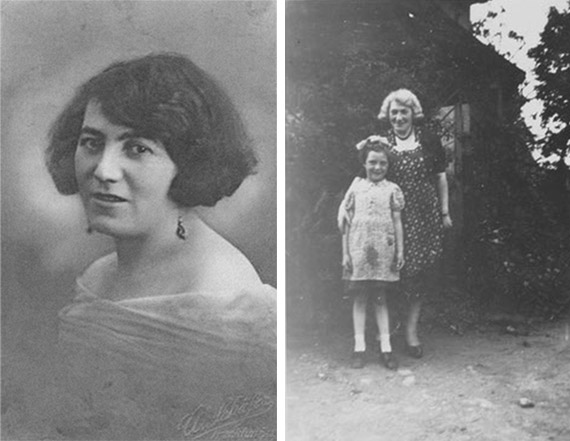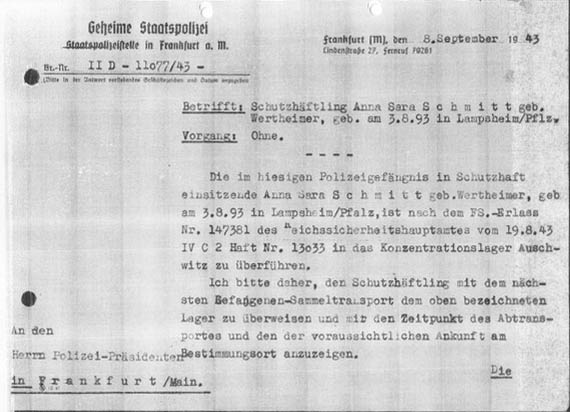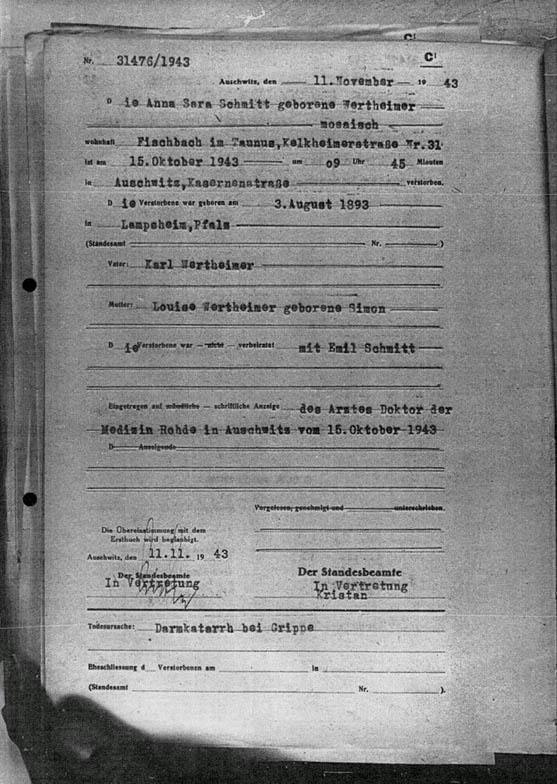Frankfurt Stories Wertheimer family
Burgstraße 19, 60316 Frankfurt am Main

The three sisters Barbara (Betty), Selma and Anna Wertheimer were born in Lambsheim in Rheinland-Pfalz and from 1907 lived in Frankfurt – none of them survived National Socialism.
Their parents Karl and Luise Wertheimer had seven children altogether. In April 1907, the family moved from Freinsheim in Rheinland-Pfalz to Frankfurt. At first they lived in Burgstraße 19 and from 1910 to 1931 in Mauerweg 10 on the second floor. The three Wertheimer sisters and their brother Ludwig lived in Mauerweg 10 with their mother and were later joined by their spouses. In 1931, the couples moved into their own apartments.The mother, now 73-years old and widowed since 1911, moved in with her daughter Betty and her husband Eugen Kloos at Textorstraße 94. She died there on 6 February 1937 and was buried in the old Jewish cemetery in Rat-Beil-Straße.
Barbara (Betty) Kloos (née Wertheimer) and Eugen Kloos
Barbara (Betty) Wertheimer, a saleswoman by profession, married the Frankfurt-born dental technician Eugen Bernhard Kloos on 6 October 1921. (The marriage certificate states Simon Scheuer from Friedberger Landstraße 129 and Betty’s brother Ludwig Wertheimer as witnesses.) They moved to Textorstraße 94 in 1931. In the city’s 1938 address book, Eugen Kloos is still listed with “Zahnwaren” (dental products) at Textorstraße 94. In 1939, they had to move to Zeil 14 to a so-called “Judenhaus” (Jew house), where those who were antisemitically persecuted were forced to live before their deportation. The couple lived there from 1939 to 1942.
On 11 June 1942, Betty and Eugen Kloos were deported to Sobibor and Majdanek. According to the list, the sixth Frankfurt special train departed in the early morning. On board were 1 253 passengers. 188 to 250 men aged between 15 and 20 were taken to Majdanek concentration camp. The death register records that Eugen Kloos died there on 22 July 1942. His wife Betty was most likely taken to Sobibor extermination camp and murdered.
Anna Schmitt (née Wertheimer) und Emil Schmitt
Anna Wertheimer, the second youngest of the Wertheimer children, married the merchant Emil Schmitt, who was not Jewish, on 10 November 1921. He worked as a salesman but was not particularly successful and suffered from an injury sustained in the First World War. He was imprisoned for a criminal offence he was said to have committed out of financial necessity. He was released on 1 Juli 1933 and with his wife moved to his home town Fischbach im Taunus, where his family also lived. At this point he was working as a furniture salesman. On 6 September 1939, he was enlisted in the Wehrmacht and discharged on 7 April 1941. The reason is unknown but possibly his marriage to a Jewish woman was the cause. Following his discharge, Emil Schmitt was arrested by the Gestapo and transferred to Natzweiler concentration camp on 19 May 1943.
Anna Schmitt was arrested on the same day, interrogated at the Gestapo headquarters in Lindenstraße 27 in Frankfurt and taken to the police prison in Klapperfeldstraße 5.
Selma Scheuer (née Wertheimer) und Simon Scheuer
On 15 March 1922, Selma Wertheimer, who had worked as a housemaid, married the merchant Simon Scheuer, who was born in Bad Soden am Taunus. It was his second marriage. He had two sons with his first wife Leopoldine, née Schüssler.
Simon Scheuer fought as a soldier in the First World War and was disabled to 70 per cent due to a bullet through his right forearm. He was awarded the Iron Cross 2nd Class, the Hessian Medal of Honour, the Wounded Badge, and the Cross of Honour for Frontline Combatants.
Selma and Simon Scheuer moved into Börnestraße 44, which was renamed Großer Wollgraben in the Nazi era. Their last address was Allerheiligenstraße 77. The couple had two daughters, Ruth and Helga. Ruth managed to escape abroad. Nothing is know of Helga’s whereabouts. Selma and Simon were on the list of Jews to be deported on 1 September 1942 to Theresienstadt.
By this time, Theresienstadt had reached a peak of 58 652 people in an area of one and a half square kilometres. People died of hunger, disease, heat, and mental suffering. Since there was not enough room for further oncoming transports, more and more people were sent to Auschwitz. Selma and Simon Scheuer were taken to Auschwitz with the transport on 28 October 1944. Only a few survived from this transport – the Scheuers were not among them.

At 6.30 in the morning of 20 September 1943, a number of women were transferred from the police prison to Auschwitz concentration camp on a train known as “special transport”. Anna Schmitt was one of them.
The death certificate of Auschwitz concentration camp dated 11 November 1943 recorded her death as 15 October 1943. The diagnosis: “intestinal catarrh due to influenza”. It is now known that information of this kind was entered randomly on death certificates.

Following the evacuation of the Natzweiler camp, Emil Schmitt was sent to Dachau concentration camp, where he was registered on 27 April 1945, two days before it was liberated by the Allies. He died in a military hospital in Bad Mergentheim on 16 December 1945, probably as a result of his concentration camp experience, and was buried in the cemetery there. There is no grave for his wife Anna.
© Heidi Stögbauer



